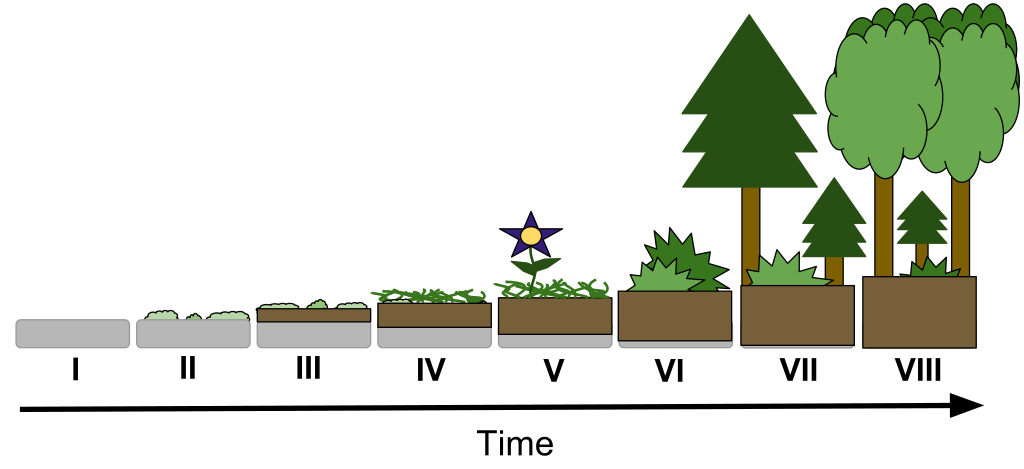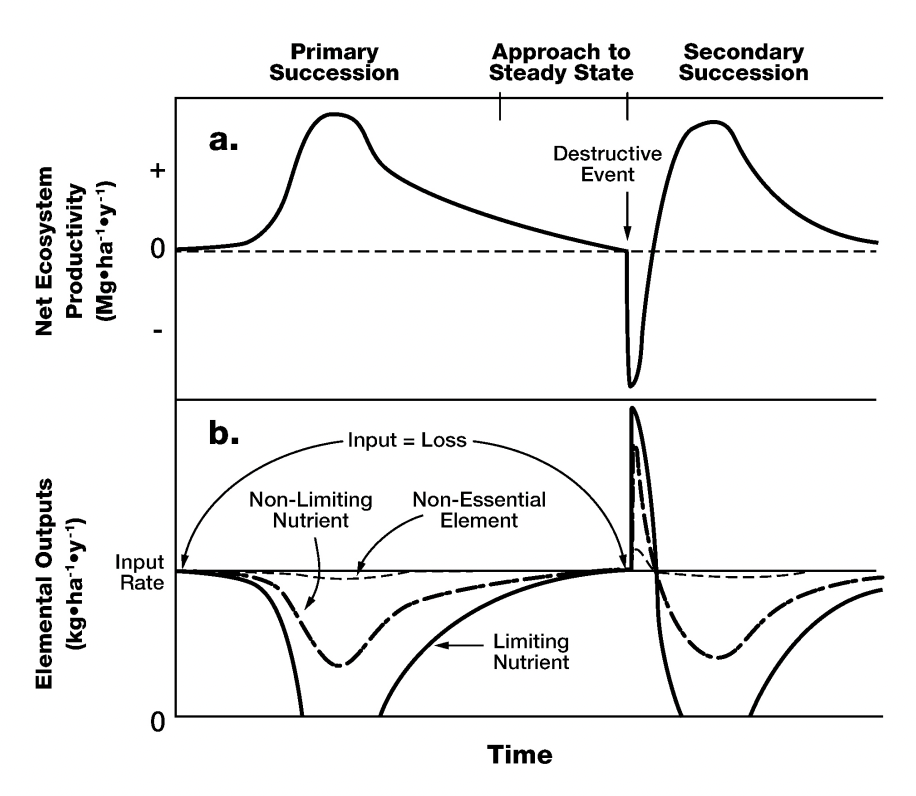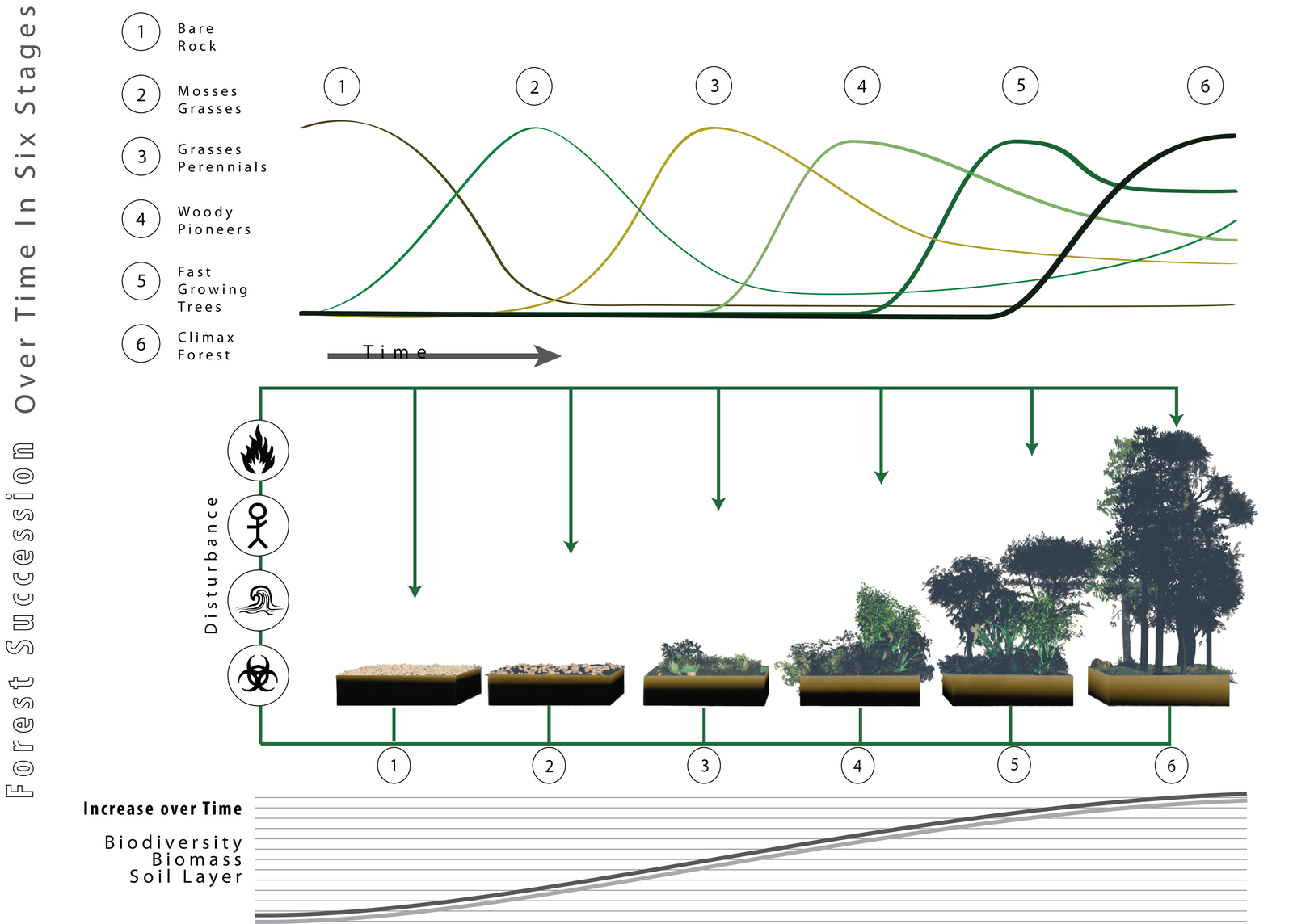IB Syllabus focus:
‘Over time, energy flow, productivity, species diversity, soil depth, and nutrient cycling typically increase; interpret data tables and figures explaining these trends.’
Succession is the gradual process of ecological change in which species composition, community structure, and ecosystem properties evolve. Over time, ecosystems become more complex, productive, and stable.
Energy Flow in Succession
During succession, energy flow through ecosystems becomes more efficient and structured. In early seral stages, energy capture is relatively low because pioneer species are few and productivity is limited. As succession advances:
Primary production increases due to greater vegetation cover.
Gross primary productivity (GPP) rises with improved photosynthetic activity from denser and taller plant communities.
Net primary productivity (NPP) initially grows rapidly, but eventually stabilises as respiration demands of a larger biomass offset gains.
This transformation reflects a shift from simple systems with rapid energy loss to complex systems that cycle energy more efficiently.
Productivity Across Seral Stages
Productivity trends follow predictable patterns:
Early stages: Low productivity due to limited soil development and nutrient availability.
Middle stages: Productivity peaks when species diversity, soil fertility, and resource availability support rapid growth.
Climax communities: Productivity stabilises at lower but sustainable levels because energy inputs and outputs reach equilibrium.
Primary productivity: The rate at which plants convert external energy and inorganic carbon into organic matter, usually measured as biomass per unit area per year.
This changing productivity is crucial for shaping the food web, supporting increasingly complex interactions.
Species Diversity and Community Complexity
Succession drives an increase in species diversity, meaning both the number of species and the complexity of their interactions.
In pioneer stages, only a few stress-tolerant species dominate.
With soil enrichment and microhabitat creation, more niches emerge.
Competition, mutualism, and predation stabilise populations and promote resilience.
Biodiversity contributes to ecosystem resilience, as varied species roles buffer against disturbances.
Soil Depth and Structure
Soil is one of the most important factors altered by succession. Initially, bare substrate has little to no organic matter. Over time:
Pioneer species such as lichens and mosses contribute organic material through death and decay.
Accumulation of humus increases soil depth and enhances water retention.
Microorganisms colonise, improving decomposition and nutrient recycling.
Soil texture and profile develop, allowing larger plants with deeper roots to establish.

Stage-by-stage primary succession from bare rock to mature forest, with visible increase in soil depth as organic matter accumulates and horizons begin forming. The panel emphasises the soil–vegetation feedback described in your notes; it includes stage labels beyond the syllabus’ minimum, which can be skimmed if unnecessary. Source.
Nutrient Cycling
Nutrient cycling becomes more efficient as succession progresses. Early systems lose nutrients quickly through leaching or runoff, but mature ecosystems conserve them better. Key changes include:
Increase in organic matter from dead plant and animal material.
Enhanced mineral uptake by a diverse range of plant species.
More developed decomposer communities, which break down detritus and recycle nutrients.
Closed nutrient loops in climax ecosystems, where inputs and outputs balance closely.
Nutrient cycling: The movement and exchange of organic and inorganic matter back into the production of living matter within an ecosystem.

Figure shows biomass accumulation (proxy for energy flow/productivity) peaking earlier in succession, alongside decreasing losses of growth-limiting nutrients as ecosystems retain nutrients more effectively. This scientific diagram adds the assumption of roughly constant nutrient inputs, a nuance beyond the syllabus but helpful for interpreting real datasets. Source.
This efficient cycling underpins long-term productivity and stability.
Interpretive Patterns in Data
Students should be able to interpret ecological data tables and figures showing succession trends. Typical patterns include:
Energy flow graphs rising steeply at first, then levelling.
Productivity curves peaking mid-succession before stabilising.
Species diversity charts showing a steady increase followed by a plateau.
Soil depth diagrams illustrating linear accumulation over time.
Nutrient cycling data demonstrating a shift from open to closed loops.

Abstract diagram of forest succession showing the rise of biomass (energy stored in living matter), increasing biodiversity, and thickening soil through seral stages toward a mature community. Lines are cleanly labelled and correspond to the trends you describe for interpreting figures. Source.
Boom–Bust Cycles vs Steady States
While most ecosystems progress towards stability, some may experience boom–bust cycles, particularly if disturbances or limiting factors interrupt succession. However, in most cases:
Steady-state climax ecosystems develop, with balanced energy inputs and outputs.
Stability arises from feedback mechanisms such as negative feedback in population dynamics and nutrient regulation.
This highlights how succession is not just about growth but also about reaching equilibrium.
Key Takeaways for Succession Changes
To summarise the alterations observed through succession, ecosystems typically exhibit:
Increased energy flow efficiency.
Rising productivity, then stabilisation.
Greater species diversity and resilience.
Enhanced soil depth and fertility.
More efficient nutrient cycling.
These trends define how ecosystems evolve towards maturity and why succession is a central concept in understanding ecological systems.
FAQ
As succession advances, ecosystems usually develop greater resilience due to increased species diversity and complex food webs. A larger variety of species ensures that if one is lost, others can fulfil similar ecological roles.
Resilient ecosystems are better at absorbing shocks like fire, drought, or disease, allowing them to recover more quickly than younger, less diverse systems.
At the climax stage, the ecosystem has reached a balance where respiration of the large biomass equals much of the photosynthetic gain.
High respiration rates in large, mature organisms offset energy capture.
Energy flow stabilises, making the system sustainable but not highly productive.
This decline reflects stability rather than inefficiency.
Decomposers break down organic material, releasing nutrients back into the soil.
Early succession: limited decomposer populations mean slower nutrient recycling.
Later succession: diverse decomposer communities improve nutrient cycling, enhancing soil fertility and supporting complex vegetation.
Their increasing role is key to sustaining productivity and biodiversity.
In early succession, soils may be acidic due to pioneer species and low organic content. Over time, as organic matter builds up and mineral weathering occurs, soil pH often rises towards neutrality.
This change supports a wider range of plant species, contributing to greater biodiversity in later successional stages.
Researchers may use:
Leaf litter decomposition rates to show how quickly nutrients return to the soil.
Nutrient concentrations in soil and water to assess retention.
Closed nutrient budgets in mature systems where nutrient inputs and outputs balance closely.
These indicators reveal how ecosystems shift from nutrient loss to efficient nutrient conservation.
Practice Questions
Question 1 (2 marks)
State two ways in which soil characteristics typically change as succession progresses.
Mark scheme:
Increase in soil depth (1 mark)
Increase in organic matter/humus content (1 mark)
Improved water retention (alternative acceptable answer) (1 mark, maximum 2)
Question 2 (5 marks)
Explain how energy flow, productivity, and species diversity change during succession, and why these changes occur.
Mark scheme:
Energy flow becomes more efficient as biomass increases and more trophic levels develop (1 mark).
Gross primary productivity (GPP) rises with denser vegetation and greater photosynthetic capacity (1 mark).
Net primary productivity (NPP) initially increases but later stabilises as respiration demands balance energy capture (1 mark).
Species diversity increases over time, with more niches available and greater community complexity (1 mark).
Changes occur due to improved soil development, nutrient cycling, and feedback between vegetation and abiotic conditions (1 mark).
(Maximum 5 marks)

